Herpes Zoster (HZ) is an acute, self-limiting, neuro cutaneous viral infection caused by the reactivation of the Varicella Zoster Virus (VZV) that remains latent in the dorsal root ganglion. About 50% of occurrence is seen in older age groups and immunocompromised patients. Less than 5% occur in children. HZ is characterized by the unilateral pain, burning and tingling sensation followed by the vesicular eruptions limited to the single dermatome that are innervated by the single cranial ganglion, sometimes it leads to Post Herpetic Neuralgia (PHN). We report a case of a HZ in a 22-year-old young female patient involving the right maxillary branch of the trigeminal nerve along with PHN.
Case Report
A 22-year-old female patient came to the Ragas Dental College and Hospital, Chennai, Tamil Nadu, India, with the complaint of intense pain and swelling in the right side of the face along with the pain in the right upper back teeth region since four days. History revealed that the patient had chicken pox when she was 2.5-year-old transmitted from her mother. Patient was an asthmatic from childhood for which she was under steroid therapy. She also had burning sensation and oedema in the right side of the face along with the continuous watering in the right eye. On examination, cluster of vesicles were present in the right middle third of the face along with the cervical lymphadenopathy. Ruptured vesicles were evident on the upper lip near the philtrum leaving an ulcerated area [Table/Fig-1,2].
Extraoral picture showing intact vesicles and oedema of right side of the face.
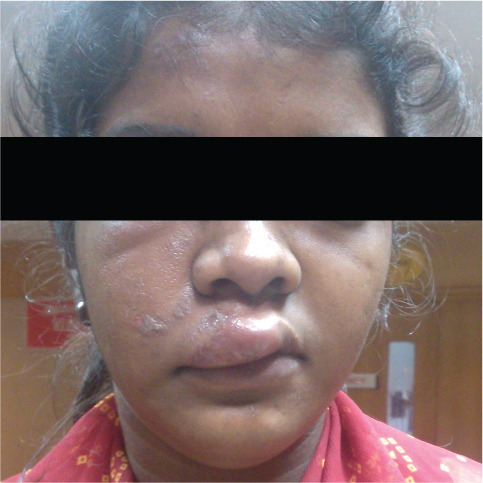
Extraoral picture showing oedema of the right eye region.
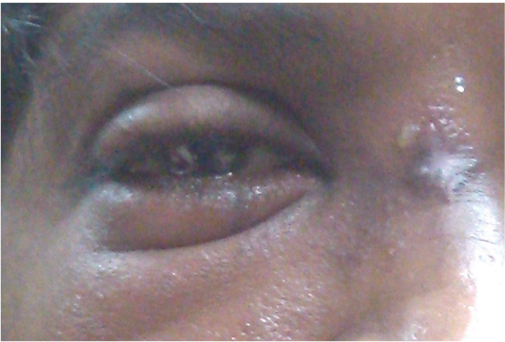
Intraoral examination revealed clusters of shallow ulcers in the right side of the upper labial mucosa, which were 3 mm in size with erythematous and irregular borders and tissue tags were seen [Table/Fig-3]. The right maxillary posterior teeth appeared normal without any dental or periodontal pathology but tenderness was elicited on percussion with teeth #14,15.
Intraoral lesion showing cluster of vesicle in the right side of the labial mucosa.
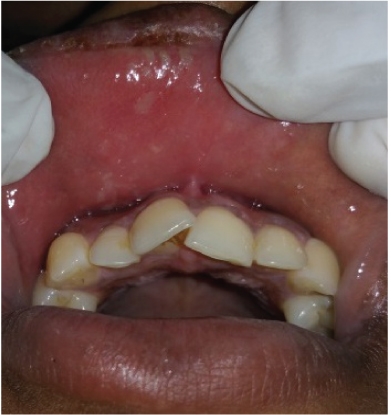
Based on the history of the unilateral intense pain and swelling along with burning sensation in the right side of the face with the dental pain in the right maxillary posterior teeth; and also the presence of vesicles along the course of the maxillary division of trigeminal nerve; it was provisionally diagnosed as HZ of right maxillary division of trigeminal nerve. The differential diagnoses included were; angioneurotic oedema, acute drug eruption and erythema multiforme, pemphigus and pemphigoid.
Investigation included Tzanck smear, in which there was numerous lymphocytes, multi nucleated giant cells, with intra nuclear inclusion bodies were seen. Differentiation of HZ and herpes simplex infection was confirmed by Polymerase Chain Reaction (PCR) [Table/Fig-4]. There was elevation in the levels of IgG and IgM antibodies against VZV. VZV IgM level was 21.9 μ/ml and VZV IgG level was greater than 150 μ/ml which was suggestive of acute infection of HZ.
Microscopic picture of the cutaneous varicella lesion under 40X magnification showing multinucleated giant cell with intra nuclear inclusion bodies.
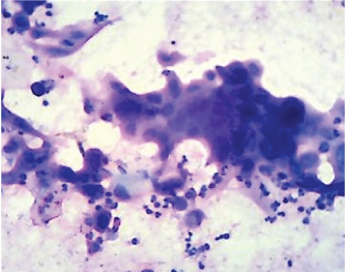
Patient was treated with tablet valacyclovir thrice daily for 15 days and also tablet gabapentin once daily for 15 days, and 0.5% acyclovir cream topically for five times a day. The patient was reviewed after 15 days showed healing of all the vesicles along with scaring, but persistence of pain in the dermatome supplied by the affected nerve was suggestive of PHN [Table/Fig-5,6]. Patient was then advised to continue tablet gabapentin for another 15 days following which the pain subsided in a month.
Three months postoperative pictures showing healing with scarring.
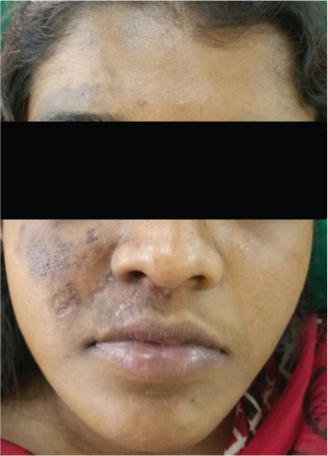
Three months postoperative pictures showing healing with scarring.
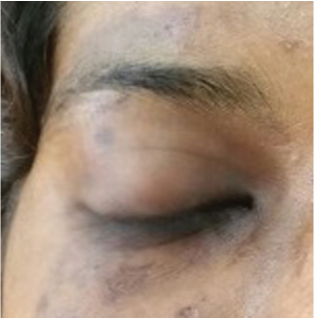
Discussion
HZ is also named as Zona or Shingles, which is a common viral disease caused by the reactivation of VZV. VZV first enters the host and infects the cells of the respiratory tract and epithelium of conjunctiva where it replicates [1]. It spreads throughout the body via reticulo-endothelial system then reaches the epidermis through the mono nuclear cells via capillary epithelium [1]. It destroys the basal cell layer leading to generalized rash of chicken pox [1]. After healing, the virus passes through the myelinated nerve fibers and reaches the perineural satellite cells of the dorsal nerve root ganglion; reactivation of virus leads to HZ [1].
Wim Opstelten et al., Chen et al., and few other authors found female predilection with 3.9/1000 patients/year in females and 2.5/1000 patients/year in males. HZ occurs most commonly in the older age groups. Chen SY et al., in his study stated that there is lower incidence of HZ among patients aged less than or equal to 65 years. [1–4]. The various triggering factors include malnutrition, patients on steroids, cytotoxic drugs, chemotherapeutic agents, diabetes, Chronic Obstructive Pulmonary Disease (COPD), malignancies such as leukaemia and lymphoma, and immune disorders [1,3,5–7]. According to Weiss R et al., trauma and stress can lead to reactivation of VZV due to reflex irritation and hyperemia of ganglion. Our case was a 22-year-old young female patient who had history of chicken pox during childhood and asthma for which she is under steroid therapy whenever she gets an attack [3].
The frequency of the involved nerves according to Costache C et al., are 48% cervical branch (C1-C4), 22% intercoastal branch (T2-T12), 15% branchial branch (C5-T1), 9% lumbar (L1- L4), 5% sacral (L5-S4). The dermatome affected in the head and neck region along with the area affected along the distribution of the affected nerve is given in [Table/Fig-7] [8–10].
Table showing dermatomes affected by herpes zoster. CN- Cranian nerve
| Dermatome affected | Area affected along the nerve distribution |
|---|
| Ophthalmic branch of CN V | Lesions involving the frontal region, upper eye lid, conjunctiva, lacrimal gland, anterior part of the scalp, involvement of ciliary ganglion causes Argyll-Robertson pupil. The involvement of nasociliary branch causes lesions in the tip and side of the nose called “Hutchinson’s sign”. |
| Maxillary branch of CN V | Lesions involving middle third of the face, lower eye lid, upper eye lid, side of the nose upper lip, nasopharynx, antrum, ethmoids, and intraorally affecting maxillary arch, buccal mucosa, uvula and tonsillar area. |
| Mandibular branch of CN V | Lesions in the lower third of the face, lower lip, temporal region and intraorally involving anterior part of the tongue, floor of the mouth, and buccal mucus membrane. |
| Facial nerve (VII) | Ramsay Hunt syndrome type I causes herpetic lesions in the oral cavity or external ear, combined with facial palsy. It is often accompanied by neurological disturbances. |
| Facial nerve with vestibulo cochlear nerve (VIII) | Ramsay Hunt syndrome type II causing facial palsy, hearing loss, vertigo and tinnitus with characteristic vesicle on external ear meatus. |
| VII with VIII, IX, X and V cranial nerve | Ramsay Hunt syndrome III associated with Frankel-Hochwart syndrome (polyneuritis cranials menieriformis). |
| Glossopharyngeal (IX) and vagal nerve (X) | Rash on the palate, posterior tongue, epiglottis, tonsillar pillars and occasionally external ear vesicles. |
| Arnold nerve which is the cervical branch of the vagus nerve | Zoster Meningo encephalitis. |
HZ, occurs in three successive stages such as prodromal, acute and chronic neuropathic stage but few patients does not develop symptoms of all the stages [1,6]. The prodromal (pre-eruptive stage) presents as pain associated with mild fever, headache and dysesthesia. Patil S et al., reported a case of HZ affecting the trigeminal nerve presenting with odontalgia [11]. This was in accordance to our case reported with history of odontalgia for past four days with neuralgia, burning and tingling sensation along the course of the affected nerve.
The acute stage is characterized by appearance of rash in a unilateral dermatome, that progress into pustule within one to seven days; then dry and form a painful crust in 14- 21 days. Intra oral lesions develop after cutaneous rash [1,6]. Oral manifestation occurs when the HZ involves the maxillary or mandibular division of trigeminal nerve [1]. Patil S et al., and Patro S et al., reported cases of HZ involving the maxillary division of trigeminal nerve extraorally showing unilateral diffuse erythema, oedematous area along with multiple vesicles involving the upper lip, zygomatic region, ala of the nose and lower eye lid and intraorally involving the upper labial mucosa and hard palate [11,12]. The distribution of vesicles along the right maxillary nerve was similar to our case, but she also had involvement of the right sided upper eye lid. Ophthalmic nerve involvement was ruled out by consulting an ophthalmologist lead to the diagnosis of HZ involving right maxillary branch of trigeminal.
The chronic neuropathic pain syndrome is also known as PHN. It is defined as a sharp, intense, radiating pain lasting after eruptive stage for about one to three months but may also last for years and decades [1,6]. It occurs due to demyelination of the affected nerve leading to pain in the affected dermatome. Lapolla W et al., stated that the prevalence of PHN ranges from 9%-73% in which pain persists even after healing of the vesicle for more than a week, month or years [13]. Lapolla W et al., also stated when gabapentin combined with valacyclovir in treating the acute herpetic zoster reduced the rate of PHN [13]. This was in accordance with our case who had persisting pain even after the healing of the vesicles, but there was decrease in the intensity of the pain after 15 days and total remission in a month duration.
Differential diagnosis such as multiple non-persistent ulcer in case of herpes simplex viral infection or recurrent aphthae, and in case of multiple persistent ulcers; lichen planus, pemphigoid or pemphigus, or immune defect due to drugs. Diagnosis is frequently done by recognizing the characteristic unilateral distribution of the lesion in case of HZ as seen in our case. Cytology (Tzanck smear) plays an important role in early diagnosis in which the viral lesion can be recognized by the presence of multinucleated giant cells (Tzanck cells) and intra nuclear inclusion bodies and numerous lymphocytes which was in accordance with our case. Other advanced diagnostic technique like fluorescent antibody staining technique and PCR can be done to identify and differentiate viral antigen. We did PCR using our patient’s serum; VZV IgM for about 21.9 μ/ml and VZV IgG was greater than 150 μ/ml where found to be elevated which is suggestive of acute infection of HZ [1,3,7].
HZ is treated by administering the antiviral drugs within 72 hours after onset of rash [1,5]. Topical antiviral agents such as 0.5% acyclovir cream and docosanol 10% cream five times a day until the lesions heal, is effective in treating herpetic infection for patients who are 12 years of age or older [1,14]. Oral administration includes acyclovir 800 mg orally 5 times daily for 7-10 days or in severe cases 10 mg/kg IV every 8 hours for 7-10 days is recommended. If acyclovir is not effective famciclovir 500 mg orally 3 times daily for 7 days is recommended; other drugs like valacyclovir 1000 mg orally 3 times daily for 7 days have been proved to be effective. In immuno compromised patients drugs such as brivudine and cidofovir for two weeks are effective. Recent advanced targeted drug therapy are directed towards the viral DNA such as ASP 2151 amenamevir inhibits helicase primase complex, FV 100 two Bicyclic Nucleoside Analogues (BCNA), Valamaciclovir Nucleoside analogue [5].
Treatment of acute pain associated with PHN is by orally administered anti convulsants such as phenytoin; 100-300 mg orally at bedtime; increase dosage until response is adequate, or blood drug level is 10-20 mg/ml, carbamazepine 100 mg orally at bedtime; increase dosage by 100 mg every 3 days until dosage is 200 mg three times daily, response is adequate or blood drug level is 6-12 mg/ ml; gabapentin 100-300 mg orally at bedtime; increase dosage by 100-300 mg every 3 days until dosage is 300-900 mg three times daily or response is adequate [1,14].
Second line of treatment is done using opioids, tricyclic antidepressants and Selective Seratonin Norepinephrine Reuptake Inhibitors (SSRI’s) [14]. Nagalaxhmi V et al., stated that prednisolone 60 mg is considered initially to reduce the acute pain but care should be taken while tapering the drug dose but the use of this drug is still controversial [14]. Other advanced treatment modalities are electrical stimulation of thalamus, anterolateral cordotomy, intercostal nerve cryotherapy, pulsed radiofrequency ablation, spinal cord stimulation, botulinum toxin injection to reduce the intensity of PHN [14].
We treated our patient with 1 g of tablet valacyclovir thrice daily and also tablet gabapentin 300 mg once daily for 15 days and 0.5% acyclovir cream topically for 5 times a day. Healing with scaring occurred after 15 days with the persistent of pain. Patient was advised to continue tablet gabapentin for another 15 days which was then followed by remission of pain. The patient was asymptomatic during continuous follow up period of three months.
Conclusion
HZ involving the trigeminal nerve can mimic other oral lesions but complication involving HZ leads to the most painful PHN. Early diagnosis by a specialist oral diagnostician and prompt treatment in the early stage helps in preventing the severity of PHN and prognosis of the disease.
[1]. Dworkin RH, Johnson RW, Breuer J, Gnann JW, Levin MJ, Backonja M, Recommendations for the management of herpes zoster. Management of herpes zosterClin Infect Dis 2007 44(1):S1-26. [Google Scholar]
[2]. Opstelten W, Van Essen GA, Schellevis F, Verheij TJ, Moons KG, Gender as an independent risk factor for herpes zoster: A population-based prospective studyAnn Epidemiol 2006 16(9):692-95. [Google Scholar]
[3]. Wareham DW, Breuer J, Herpes zoster; clinical reviewBMJ 2007 334(77605):1211-15. [Google Scholar]
[4]. Chen SY, Suaya JA, Li Q, Galindo CM, Misurski D, Burstin S, Incidence of herpes zoster in patients with altered immune functionInfection 2014 42:325-34. [Google Scholar]
[5]. Bandral MR, Chidambar YS, Telkar S, Japatti S, Choudary L, Dodamani A, Oral complications of herpes zoster infection- report of 3 casesInternational Journal of Dental Clinics 2010 2(4):70-73. [Google Scholar]
[6]. Asha ML, Chatterjee I, Patil P, Vijayan A, Herpes zoster leading to viral osteomyelitis or neuralgia inducing cavitational osteonecrosis? – A case report and review of literatureInt J Sci Stud 2014 2(6):125-30. [Google Scholar]
[7]. Kashinath KR, ChandraShekar L, Herpes zoster along maxillary nerve with osteonecrosis; Case reportJournal of Dental Sciences and Research 2011 2(1):12-17. [Google Scholar]
[8]. Costache C, Costache D, A study of the dermatomers in herpes zosterBulletin of the Transilvania University of Brasov 2009 2(51):19-24. [Google Scholar]
[9]. Naveen KN, Pradeep AV, Arun Kumar JS, Hegde SP, Pai VV, Athanikar SB, Herpes zoster affecting all three divisions of trigeminal nerve in an immunocompetent male: A rare presentationIndian J Dermatol 2014 59(4):423 [Google Scholar]
[10]. Vajpayee M, Malhotra N, Antiviral drugs against herpes infectionsIndian Journal of Pharmacology 2000 32:330-38. [Google Scholar]
[11]. Patil S, Srinivas K, Satheesha Reddy BH, Gupta M, Prodromal herpes zoster mimicking odontalgia – A diagnostic challengeEthiop J Health Sci 2013 23(1):73-77. [Google Scholar]
[12]. Patro S, Jena PK, Misra GC, Rath KC, Khatua P, Herpes zoster infection involving the maxillary branch of the right trigeminal nerve - A rare case reportThe Antiseptic 2013 110(1) [Google Scholar]
[13]. Lapolla W, DiGiorgio C, Haitz K, Magel G, Mendoza N, Grady J, et al, Incidence of postherpetic neuralgia after combination treatment with gabapentin and valacyclovir in patients with acute herpes zosterArch Dermatol 2011 147(8):901-07. [Google Scholar]
[14]. Nagalaxmi V, Singh A, Srikanth K, Prameela K, Reddy S, An insight to herpes zoster review articleGlobal Journal of Medical Research: J Dentistry and Otolaryngology 2014 14(3):22-28. [Google Scholar]